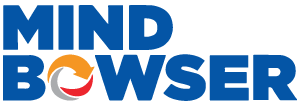Over the last few years, telehealth has evolved from a backup plan into a baseline expectation. What was once a short-term solution for pandemic-era disruptions has now become a standard part of care delivery. But the truth is—a single video visit isn’t enough anymore.
Today’s patients expect more than access. They expect continuity.
As Kim-Fredrik Schneider, CEO of Abi Global Health, notes in the HealthTech with Purpose podcast series, access remains a foundational challenge, even as technology evolves.
“The big problem we’re solving is one of healthcare access and health equity… stopping people from accessing healthcare is an undersupply of professionals.”
Kim-Fredrik Schneider
CEO of Abi Global Health
Providers are seeking tools that extend beyond screen-to-screen consultations. And investors are no longer backing “apps.” They’re looking for scalable platforms that support long-term clinical outcomes, reduce the cost of care, and enable flexibility across specialties.
That’s where virtual care comes in. It’s not just about one interaction; it’s about creating a connected, repeatable, and patient-centered care model that functions across time, locations, and conditions. At the center of it all is software purpose-built to enable these workflows securely and reliably.
This guide is written for founders who are either planning their telehealth product or looking to scale it up. You’ll find key insights on product vision, essential features, integration strategies, and lessons from real platforms that have scaled virtual care delivery across multiple specialties.
If you’re building or scaling a healthcare platform in 2024, you’re not just creating a telehealth tool. You’re building the infrastructure for how care will be delivered virtually for years to come.
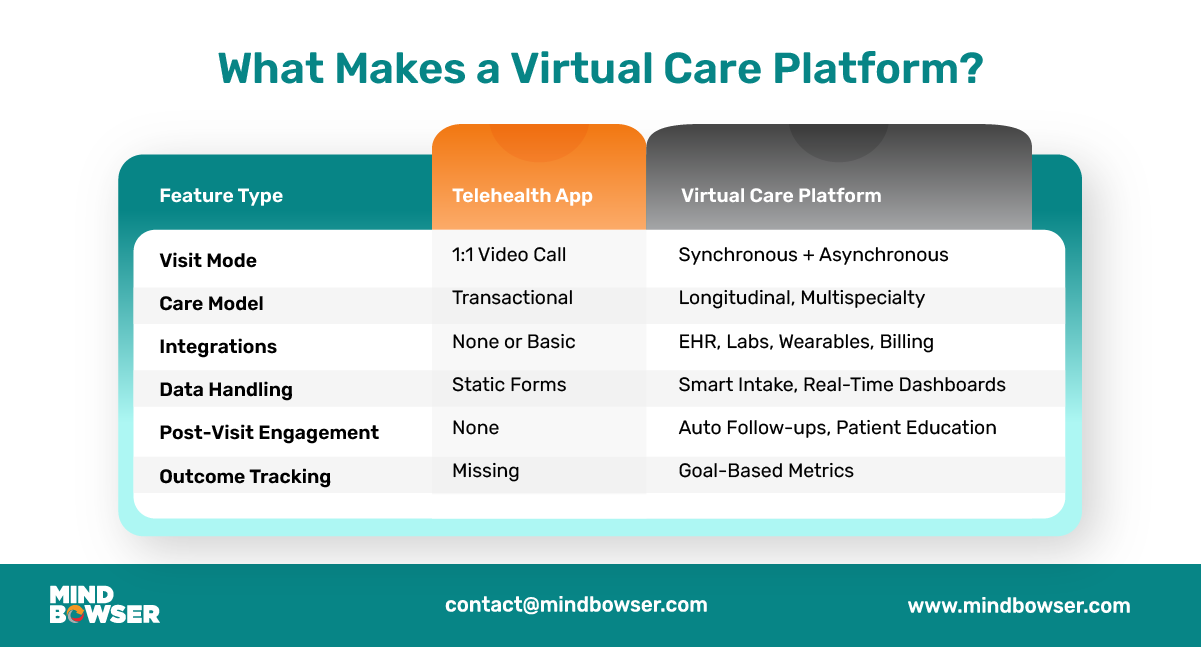
One of the most common mistakes early-stage founders make is starting with features rather than addressing a problem. In healthcare, this approach is especially risky. Without a clear understanding of the care model, the clinical workflows involved, and the end-user expectations—whether those users are patients, providers, or care managers—you risk building a product that doesn’t scale, doesn’t get adopted, or worse, doesn’t improve care.
That’s why the first step in telehealth software development isn’t about wireframes or tech stacks. It’s about defining your vision for virtual care.
Are you focused on behavioral health therapy, remote cardiac rehab, maternal care, or chronic condition management like diabetes or hypertension? Each model brings its own set of requirements:
The workflows are different, the regulatory expectations vary, and the user behavior can’t be generalized. When you define the clinical model clearly, you shape the product roadmap with accuracy and purpose.
Related read: Streamlining Behavioral Healthcare with Epic EHR Integration: Enhancing Efficiency and Patient Care
Telehealth isn’t a novelty anymore—it’s an infrastructure layer. So ask:
What specific gap are you trying to fill?
The clearer your problem, the more valuable your platform becomes to payers, health systems, and patients alike.
Founders often chase features that seem impressive—like AI symptom checkers or EHR dashboards—without connecting them to tangible results.
Set goals based on what matters:
These outcomes will guide your platform’s architecture, feature set, and data strategy.
In an episode of the HealthTech with Purpose podcast, our CEO, Ayush Jain, spoke with Cavan Klinsky, co-founder and CTO of Healthie, about how founders often underestimate the rhythm of healthcare adoption.
“Startups move much more slowly than people expect… and healthcare moves even slower.”
Cavan Klinsky
Co-Founder of Healthie
Ayush and Cavan agreed that one of the most overlooked truths in digital health is how long it takes to turn a working product into an adopted workflow. That’s why tying success to real-world outcomes—like patient engagement, reduced hospitalization, or provider satisfaction—is more valuable than chasing shiny features with no clinical validation.
Real-World Examples
Therapy models designed for high-stress professionals often prioritize flexible scheduling, secure asynchronous communication, and support for continuity across multiple sessions. This approach reflects the day-to-day needs of users who require discreet, consistent mental health support without generic workflows.
In fertility care, virtual-first models are now enabling users to complete clinical testing at home, manage diagnostics like ultrasounds digitally, and receive results securely. These platforms don’t mirror traditional in-clinic processes—they restructure them for convenience, privacy, and efficiency.
Both platforms succeeded because they didn’t try to do everything. They understood who they were serving, what problems they were solving, and how success would be measured. That’s what separates a virtual care platform from a basic telehealth tool.
Let’s map your care model and translate it into a scalable product strategy.
A successful telehealth platform does far more than enable a video call. In today’s healthcare environment, delivering virtual care requires a complete ecosystem—one that supports the full journey of both the patient and the provider. From pre-visit intake to post-visit care planning, your platform needs to handle a range of tasks that have historically been performed across multiple systems, phone calls, and even paper records.
Below is a breakdown of the essential features that founders should consider when planning telehealth software development—not just to launch an MVP, but to build a platform with staying power.
The foundation of any telehealth product is the ability to conduct HIPAA-ready video consultations. But it’s not enough to embed a generic video tool. Your platform should include:
Security, reliability, and patient ease of use must be built in from the start. If the video fails, the platform fails.
Coordinating appointments should be effortless. Platforms like Mindbowser’s AutoConfirm AI enable:
This reduces administrative burden and dramatically cuts down on no-shows.
Intake forms and pre-visit data collection are often neglected. But for many specialties—such as behavioral health, chronic care, and pediatrics—they’re essential. Our workflow TelePrep AI enables platforms to:
It’s not just about efficiency. It’s about improving the quality and focus of the encounter.
This is non-negotiable if you’re planning to scale. Manual data entry between your app and a clinic’s EHR slows down adoption and invites errors. With our workflows like HealthConnect CoPilot, your platform can:
This is often the biggest technical hurdle, but also the one that unlocks long-term viability in the enterprise space.
Not every healthcare interaction requires synchronous communication. Patients often have follow-up questions, clarifications, or requests for documentation. Your platform should offer:
This builds continuity and reduces the pressure on providers to address everything in one session.
For platforms entering the US payer market, real-time insurance validation can be a game-changer. Using our workflow InsureVerify AI, platforms can:
This feature saves providers and billing teams hours per week and supports revenue integrity.
A visit shouldn’t end when the video call ends. Ongoing care depends on clear next steps. With our workflows like EduCare AI and CarePlan AI, your platform can:
This turns your app from a utility into a trusted part of the patient’s ongoing care.
Most MVPs in digital health are designed to get a quick demo out the door. They showcase a video call feature, basic scheduling, and maybe even a login page for providers. And while that’s good enough to raise eyebrows or sometimes even capital, it rarely holds up when it’s time to pilot with a real clinic, integrate with an EHR, or expand across multiple care specialties.
If you’re serious about building a virtual care platform, your architecture must support more than the features you’re shipping today. It needs to be designed for how healthcare works in real time, across multiple devices, and within regulated environments.
Here’s what that means in practice.
Modular architecture isn’t just a software buzzword. In healthcare, it’s the difference between iterating fast and rebuilding from scratch every time you want to add a new feature.
Your architecture should be broken into services or components that can operate independently—things like:
When you design with modularity in mind, you don’t have to redesign your entire product every time a new customer requests a change. This is especially important when working across specialties. A platform serving behavioral health will need different workflows than one handling post-surgical rehab.
Even if you start with a single use case, planning for modular growth enables you to scale without compromising stability.
Choosing where and how you host your platform is one of the earliest—and most critical—decisions you’ll make. Your cloud infrastructure should not only be scalable but also meet the privacy and security requirements of HIPAA and other healthcare regulations.
For most startups, this means utilizing AWS, GCP, or Azure with services that are HIPAA-compliant. These platforms allow you to:
HIPAA isn’t something you “add” later. Your infrastructure needs to support it from the start if you want any chance of integrating with providers, payers, or clinical research partners.
Michael Archuleta, CIO at Mt. San Rafael Hospital and Clinics, framed it well in a conversation on HealthTech with Purpose podcast:
“Hospitals and clinics are digital companies that deliver healthcare services.”
Michael Archuleta
CIO at Mt. San Rafael Hospital and Clinics
It’s a mindset shift that early-stage founders must internalize. You’re not just building software—you’re building the digital layer of care delivery. If your product isn’t architected to meet the operational expectations of clinical environments, it won’t survive in the long term.
Bonus: Hosting in a compliant cloud environment also speeds up conversations with potential enterprise clients and partners who will want to know how data is stored and protected.
You don’t need to reinvent the wheel to build something innovative. What matters is that your tech stack allows you to move quickly without sacrificing quality or maintainability.
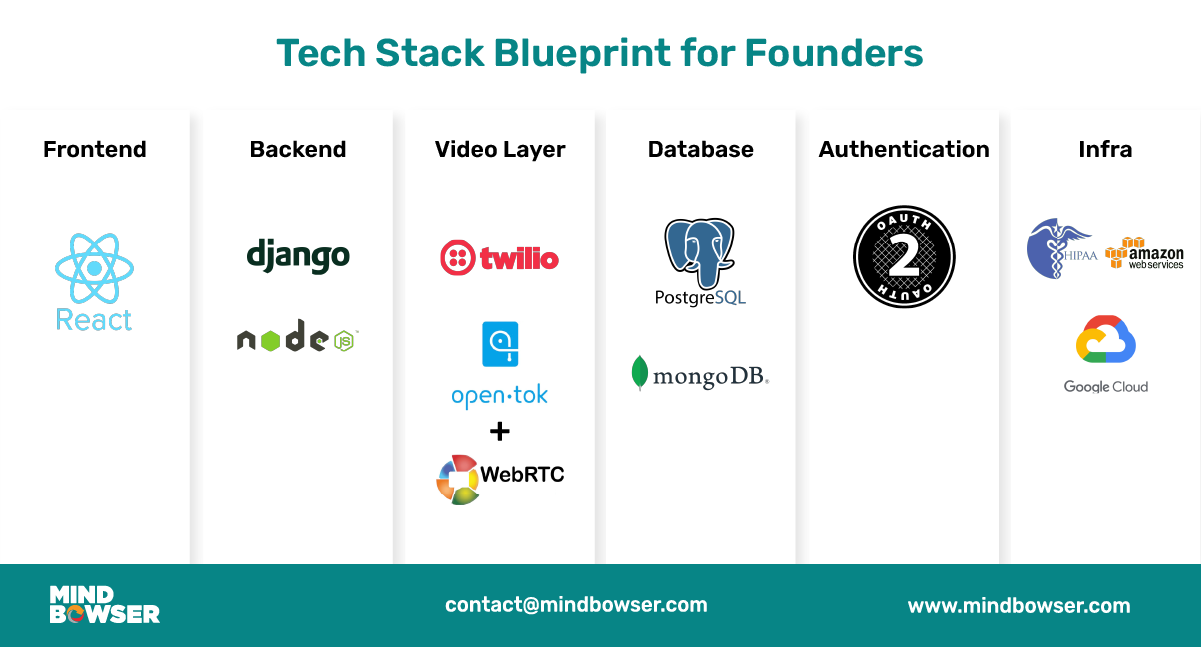
Here’s a proven combination that works well for most telehealth platforms:
This stack is widely supported, security-focused, and developer-friendly. It also integrates well with third-party APIs and platforms, such as Stripe, SendGrid, or Zoom, if you need to incorporate external functionality.
In healthcare, there’s very little margin for error. Laggy video, lost session notes, or a failed upload isn’t just a bad user experience—it can delay care or lead to medical risk. Your architecture must account for:
These aren’t just “nice to haves.” If you want to support clinicians, your platform has to perform like an extension of their workflow—not a workaround they dread logging into.
You don’t need to build every feature on day one. But your architecture should assume that:
Founders often think they’re saving time by hardcoding things that will “get fixed later.” However, rebuilding core logic midway through implementation is where momentum dies and costs accumulate.
Contextual Example:
Replacing traditional, hardware-heavy diagnostic tools with mobile-first, cloud-native alternatives requires thoughtful engineering. In one such case, a virtual care platform reimagined endoscopic workflows by enabling high-resolution image capture, secure real-time streaming, and compliant cloud storage—all without sacrificing clinical accuracy. By utilizing WebRTC-based video and HIPAA-compliant cloud infrastructure, the system enabled real-time access for physicians while reducing dependency on in-person diagnostic setups.
Their success wasn’t in building fast—it was in building right.
Takeaway: If you want your platform to evolve beyond a one-feature tool, your architecture needs to be more than functional. It needs to be foundational. Founders who treat their system as a long-term asset—not just a short-term experiment—will find it easier to scale, integrate, and retain clinical partners.
We’ve helped over 40 healthtech founders scale from prototype to production—with cloud-native, HIPAA-compliant builds.
AI in healthcare isn’t about buzzwords or hypothetical use cases—it’s about solving real problems at critical points in the care journey. In the context of virtual care, AI has the potential to shift your platform from a transactional tool into a longitudinal care experience.
When used thoughtfully, AI can reduce administrative overhead, help providers focus on clinical decision-making, and enable patients to take more ownership of their health—all while improving the quality, safety, and efficiency of care delivery.
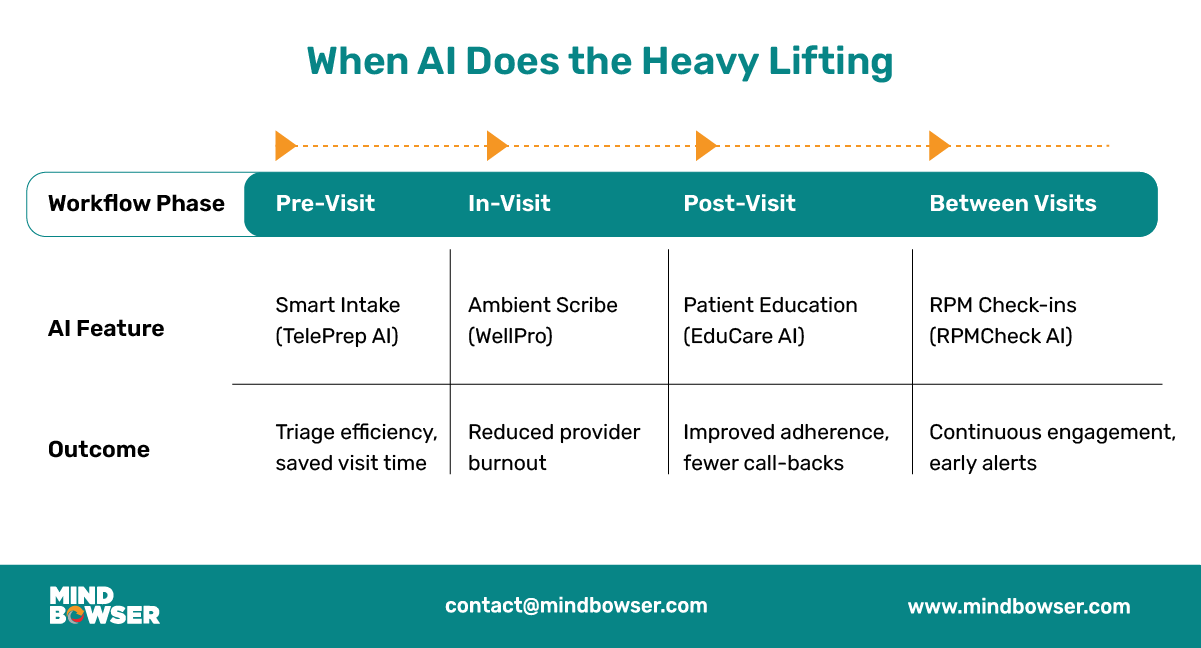
Let’s break down where AI brings meaningful value in telehealth software development.
When a patient books a virtual appointment, they often arrive at the visit without structured documentation of their symptoms, medications, or concerns. This forces providers to spend the first several minutes just collecting context—a process that not only eats into visit time but also leads to missed or misinterpreted details.
AI-powered intake, such as what TelePrep AI enables, allows your platform to:
This improves visit quality and reduces provider burden, especially in high-volume or asynchronous care models.
Care doesn’t end when the video call is over. Whether you’re supporting post-operative recovery, rehab progress, managing chronic conditions, or following up on behavioral health, the platform must facilitate ongoing engagement.
With AI-enabled workflows like RPMCheck AI, you can:
This is especially effective in virtual-first programs, where the clinical team cannot physically observe progress in recovery. It adds a layer of safety, accountability, and convenience.
One of the top reasons clinicians resist telehealth platforms is the documentation burden. Manually typing SOAP notes, prescriptions, and follow-up tasks during or after a visit can increase screen time and lead to burnout.
That’s where ambient AI comes in—offering contextual support without taking over the clinical decision-making process. For example, platforms are already implementing:
The goal here is not to replace the provider; rather, it is to enhance their services. It’s to make sure their time is spent on clinical thinking, not paperwork.
Patients often leave a visit without fully understanding their diagnosis or next steps. AI can help by delivering personalized content—either during or after the visit—based on what was discussed.
With workflows like EduCare AI, you can:
This not only improves health literacy but also reduces the chances of follow-up calls or medication errors.
For Example:
A modern virtual care workflow can be significantly improved with intelligent documentation support. One platform utilizes real-time transcription to capture provider-patient conversations, structures the output into clinical notes, and automatically generates post-visit actions—all without disrupting the provider’s workflow. This enables clinicians to focus on care delivery rather than managing multiple tools or manually entering repetitive data.
Founders, Here’s What to Remember:
If you get this right, AI becomes a trusted co-pilot in your platform—not a gimmick.
Related read: Challenges of Telemedicine and Their Potential Breakthroughs
Most founders start with a narrow use case. That’s a smart move. It keeps scope tight, development fast, and go-to-market clear. However, many teams struggle to transition their focused MVP into a scalable platform that can grow across providers, care types, and business models.
Scaling a virtual care platform isn’t about piling on features. It’s about designing a system that can adapt to new specialties, integrate with various workflows, and support more users without compromising its performance.
Here’s how to think about scale from day one, even while you’re still building your first release.
Let’s say your MVP is focused on cardiac rehab. You’ve got BLE device support for heart rate tracking, a content library for home-based exercises, and a dashboard for care teams to monitor progress. Great.
But what happens when:
If you hard-code everything around the initial condition, you’ll be rebuilding. However, if you utilize modular services (e.g., vital monitoring, care plans, educational content, scheduling) that can be customized per specialty, you’ll be able to grow faster and more sustainably.
This is where platform thinking starts to pay off.
Every new specialty or care pathway doesn’t need to start from scratch. At Mindbowser, we’ve built workflows that allow teams to plug in new workflows quickly, like:
Instead of building custom logic for every new module, founders can use these reusable components to test and validate new pathways without a major engineering lift.
This approach also reduces cost and risk when entering new markets or specialties.
As your platform grows, so will the operational expectations that come with it. That means your architecture and product design must support:
This isn’t just about UI flexibility. It’s about permissions, data separation, and system resilience.
If you want your product to be adopted across health systems or care networks, you’ll need to solve for scale not just in terms of users but in terms of governance and complexity.
Consumer-facing health apps often hit a ceiling when they try to work with enterprise clients. Why? Because they weren’t designed with enterprise needs in mind:
Even if you start with a direct-to-consumer product, building with these needs in mind sets you up for B2B partnerships later.
Your first payer or provider client will ask questions your MVP never had to answer. If you build with scale in mind, you’ll be ready.
Takeaway for Founders:
Don’t wait until you have scale to plan for scale. Start with a focused use case—but build your foundation as if the platform will one day power five different specialties, ten different workflows, and multiple payer models. Because if you build something that works, growth won’t be the hard part. Adapting to it will.
Utilize our pre-built workflows, such as CarePlan AI and RPMCheck AI, to launch faster without having to reinvent the wheel.
No founder sets out to build something that falls short of their goals. But in digital health—where timelines, trust, and technical debt intersect—it’s easy to get stuck in patterns that lead to bloated MVPs, poor adoption, or platform reworks. Most of these issues aren’t technical—they’re strategic.
Avoiding these pitfalls doesn’t just save you engineering hours—it saves your product’s credibility with clinicians, investors, and enterprise buyers.
Let’s walk through the most common traps.
Many early-stage telehealth platforms are built in isolation. They assume EHR, lab, or device integration is something to “figure out later.” This creates major blockers when your first pilot customer—or investor—asks:
“Can this connect to our system?”
If your product doesn’t support industry standards like FHIR, HL7, or CCD, you’re immediately disqualified from many partnerships. Worse, retrofitting integrations post-launch is expensive, time-consuming, and often introduces bugs or security issues.
✅ Plan your data model, APIs, and architecture to support interoperability—even if it’s not needed on Day 1.
Too often, founders design UX flows based on what seems intuitive, instead of how clinicians work. That leads to friction, drop-off, or outright rejection.
Example missteps:
You’re not just building a user experience—you’re embedding yourself into a clinical workflow. If your platform adds friction instead of removing it, clinicians will abandon it—even if patients like it.
Involve 2–3 clinicians during wireframe reviews and user testing. Their feedback will save you months.
Telehealth is often equated with real-time video visits. However, for many specialties—such as behavioral health, rehabilitation, maternal care, and chronic management—the real value lies in what happens between live sessions.
Founders who only focus on synchronous care miss key opportunities:
✅ Build for continuity, not just connection.
It’s tempting to overemphasize the beauty of screens. After all, early demos and investor decks depend on polish. But if you can’t tie your UI to a clinical or operational outcome, it’s just design theater.
Good design in healthcare:
At Mindbowser, we’ve spent over a decade helping digital health companies bring their visions to life. We’ve partnered with founders at every stage—from napkin sketches to live, revenue-generating platforms—and we understand the nuances that make healthcare software distinct from other types of software.
Building a virtual care platform isn’t just about hiring engineers. It’s about assembling a product team that understands the complexity of healthcare, clinical workflows, privacy mandates, and user behaviors across patients, providers, and administrators.
Here’s how we bring that to life.
Our teams don’t just write code. We’ve designed and built 40+ digital health products across virtual care, remote patient monitoring, chronic disease management, fertility, pediatrics, and wellness.
What we offer:
Whether you’re building from scratch or rebuilding something that can’t scale, we embed with your team to deliver healthcare-grade software with startup speed.
One of the biggest roadblocks for founders is the time and cost required to build core platform functionality. We solve that with pre-built workflows that integrate seamlessly with your product:
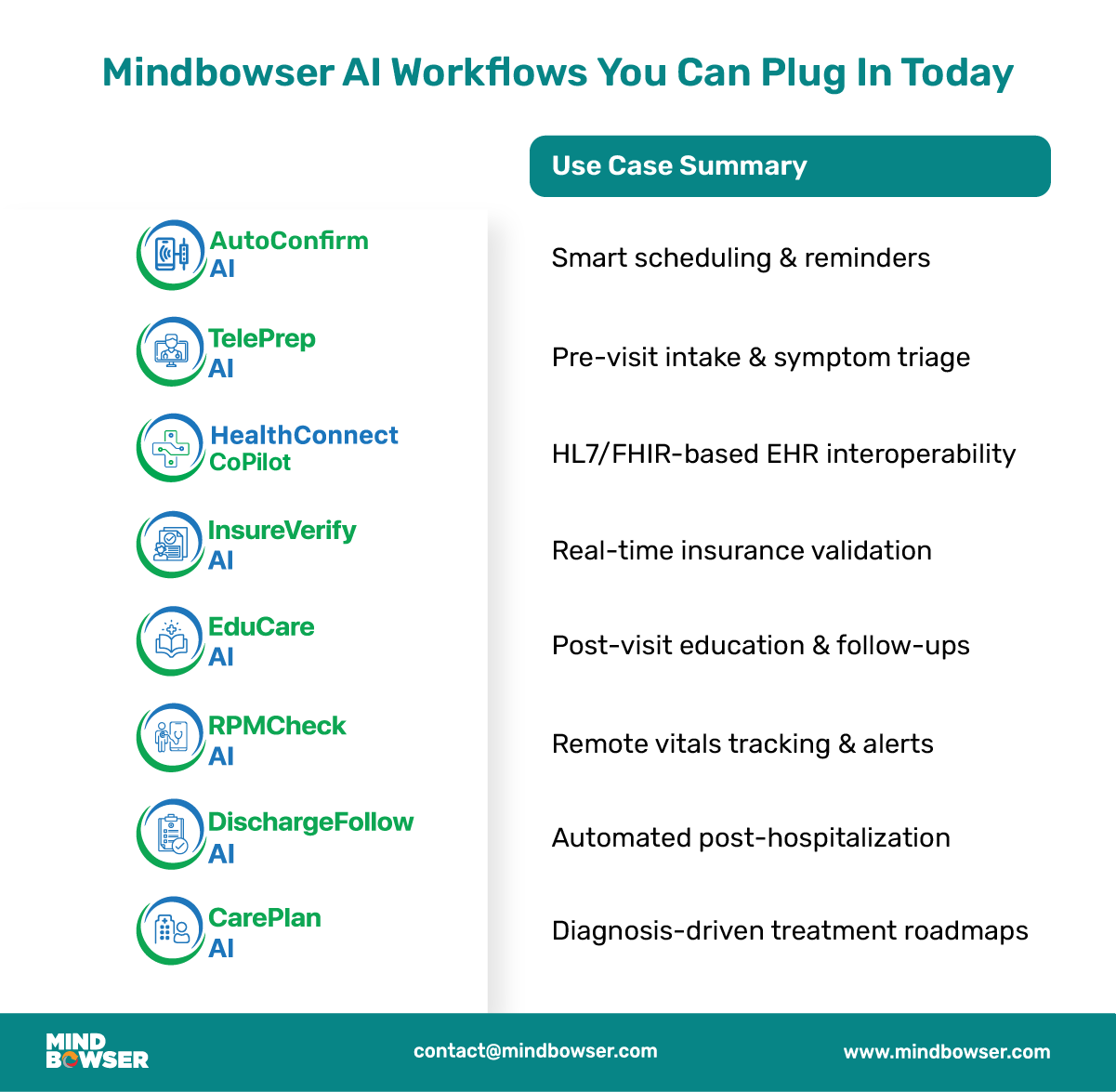
These accelerators reduce development time by 30–40%, enabling faster pilots, cleaner architecture, and stronger outcomes from Day 1.
Enterprise buyers prioritize scale, reliability, and seamless integration. So do we.
We help platforms plug into:
Because we’ve undergone dozens of security reviews, we can help you prepare for them too—from documentation to architecture to walkthroughs.
What You Get Working With Mindbowser:
Whether you’re an early-stage founder or a product leader at a growth-stage startup, we meet you where you are—and help you get to where you want to be, faster and smarter.

Virtual care isn’t a side feature anymore; it’s the new foundation for how healthcare gets delivered. Whether it’s behavioral health, chronic condition management, or post-surgical rehab, patients and providers now expect continuous, accessible, and intelligently supported care beyond the clinic walls.
For founders, this means telehealth software development has to move beyond the idea of just “replicating” the in-person experience. Your goal isn’t to port doctor visits onto a screen—it’s to rethink care delivery for a digital-first world.
The difference between platforms that scale and those that stall comes down to how they’re built.
✔ Did you define the clinical model clearly before building?
✔ Did your MVP architecture allow for integrations and new workflows?
✔ Are you using AI to reduce admin load and increase patient engagement?
✔ Are your features focused on solving real-world problems—not just checking boxes?
Successful virtual care platforms are outcome-driven, modular by design, and connected to the broader healthcare ecosystem. They support real-time interactions, asynchronous messaging, personalized content, and post-visit continuity—all wrapped in a secure, scalable infrastructure.
And just as importantly, they’re built with the long term in mind.
Telehealth software development involves creating digital platforms that facilitate remote healthcare services, including video consultations, appointment scheduling, patient intake, EHR integration, and ongoing virtual care workflows. It requires secure infrastructure, interoperability with clinical systems, and a user-friendly design that is both accessible to patients and providers.
A robust virtual care platform should support secure video visits, automated scheduling, smart intake forms, real-time chat, EHR integration (using FHIR or HL7), remote patient monitoring, post-visit education, and asynchronous communication—all working together to support end-to-end care.
AI enhances telehealth platforms by automating symptom triage, scheduling, documentation, patient education, and remote monitoring. It helps providers save time, improves patient engagement, and supports personalized care without adding administrative burden.
Startups can scale by using a modular architecture, building with EHR and wearable device integrations in mind, and leveraging solution accelerators for features such as discharge follow-ups, vital tracking, and personalized care plans. Planning for multiple specialties and care workflows early ensures a smoother growth trajectory.

We worked with Mindbowser on a design sprint, and their team did an awesome job. They really helped us shape the look and feel of our web app and gave us a clean, thoughtful design that our build team could...


The team at Mindbowser was highly professional, patient, and collaborative throughout our engagement. They struck the right balance between offering guidance and taking direction, which made the development process smooth. Although our project wasn’t related to healthcare, we clearly benefited...

Founder, Texas Ranch Security

Mindbowser played a crucial role in helping us bring everything together into a unified, cohesive product. Their commitment to industry-standard coding practices made an enormous difference, allowing developers to seamlessly transition in and out of the project without any confusion....

CEO, MarketsAI

I'm thrilled to be partnering with Mindbowser on our journey with TravelRite. The collaboration has been exceptional, and I’m truly grateful for the dedication and expertise the team has brought to the development process. Their commitment to our mission is...
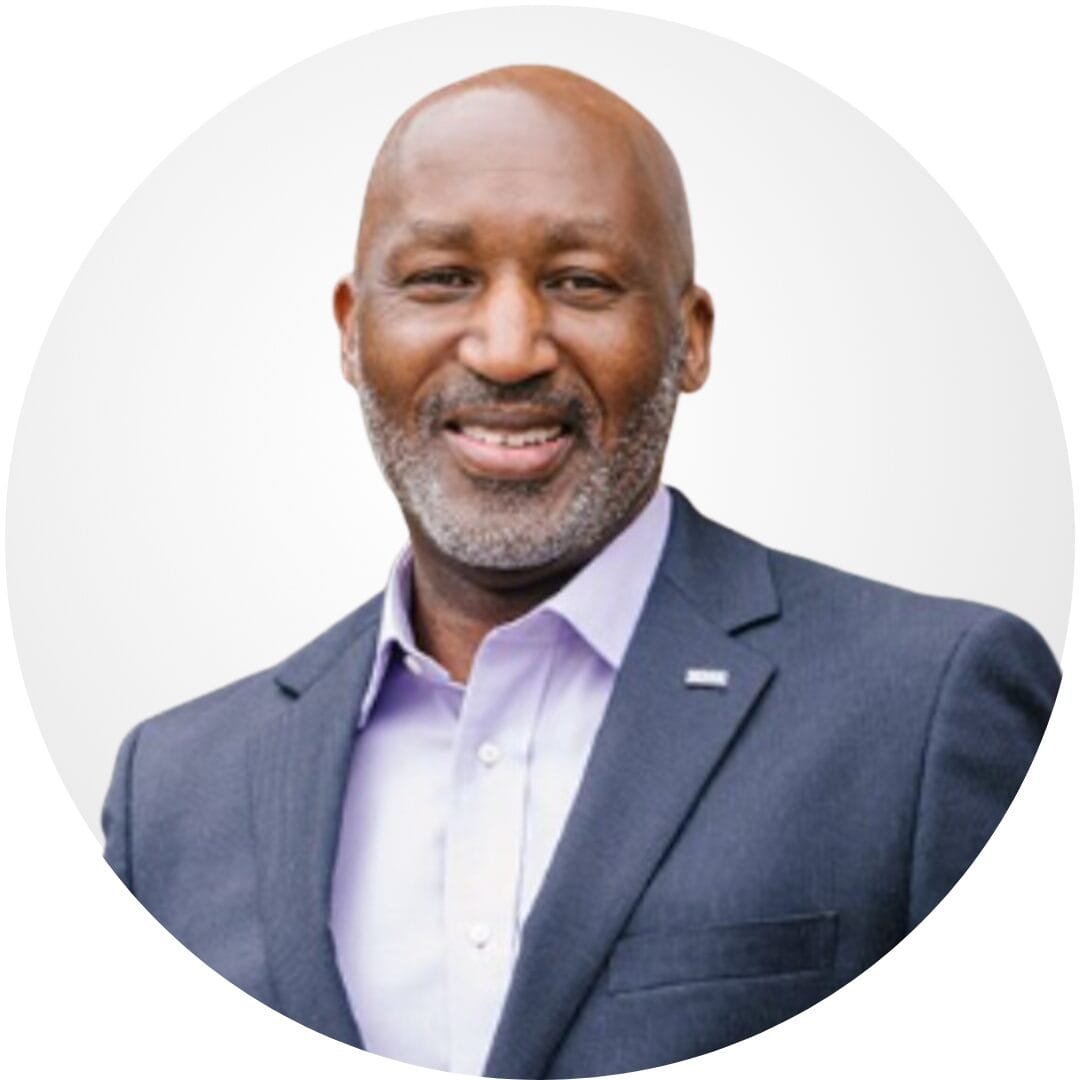
Founder & CEO, TravelRite

The Mindbowser team's professionalism consistently impressed me. Their commitment to quality shone through in every aspect of the project. They truly went the extra mile, ensuring they understood our needs perfectly and were always willing to invest the time to...

CTO, New Day Therapeutics

I collaborated with Mindbowser for several years on a complex SaaS platform project. They took over a partially completed project and successfully transformed it into a fully functional and robust platform. Throughout the entire process, the quality of their work...

President, E.B. Carlson

Mindbowser and team are professional, talented and very responsive. They got us through a challenging situation with our IOT product successfully. They will be our go to dev team going forward.

Founder, Cascada

Amazing team to work with. Very responsive and very skilled in both front and backend engineering. Looking forward to our next project together.

Co-Founder, Emerge

The team is great to work with. Very professional, on task, and efficient.

Founder, PeriopMD

I can not express enough how pleased we are with the whole team. From the first call and meeting, they took our vision and ran with it. Communication was easy and everyone was flexible to our schedule. I’m excited to...

Founder, Seeke

We had very close go live timeline and Mindbowser team got us live a month before.

CEO, BuyNow WorldWide

Mindbowser brought in a team of skilled developers who were easy to work with and deeply committed to the project. If you're looking for reliable, high-quality development support, I’d absolutely recommend them.

Founder, Teach Reach

Mindbowser built both iOS and Android apps for Mindworks, that have stood the test of time. 5 years later they still function quite beautifully. Their team always met their objectives and I'm very happy with the end result. Thank you!

Founder, Mindworks

Mindbowser has delivered a much better quality product than our previous tech vendors. Our product is stable and passed Well Architected Framework Review from AWS.

CEO, PurpleAnt

I am happy to share that we got USD 10k in cloud credits courtesy of our friends at Mindbowser. Thank you Pravin and Ayush, this means a lot to us.

CTO, Shortlist

Mindbowser is one of the reasons that our app is successful. These guys have been a great team.

Founder & CEO, MangoMirror

Kudos for all your hard work and diligence on the Telehealth platform project. You made it possible.

CEO, ThriveHealth

Mindbowser helped us build an awesome iOS app to bring balance to people’s lives.

CEO, SMILINGMIND

They were a very responsive team! Extremely easy to communicate and work with!

Founder & CEO, TotTech

We’ve had very little-to-no hiccups at all—it’s been a really pleasurable experience.

Co-Founder, TEAM8s

Mindbowser was very helpful with explaining the development process and started quickly on the project.

Executive Director of Product Development, Innovation Lab

The greatest benefit we got from Mindbowser is the expertise. Their team has developed apps in all different industries with all types of social proofs.

Co-Founder, Vesica

Mindbowser is professional, efficient and thorough.

Consultant, XPRIZE

Very committed, they create beautiful apps and are very benevolent. They have brilliant Ideas.
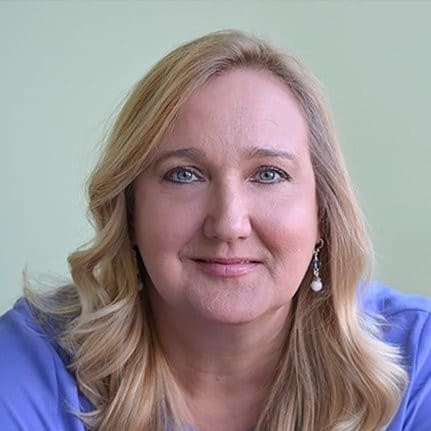
Founder, S.T.A.R.S of Wellness

Mindbowser was great; they listened to us a lot and helped us hone in on the actual idea of the app. They had put together fantastic wireframes for us.

Co-Founder, Flat Earth

Mindbowser was incredibly responsive and understood exactly what I needed. They matched me with the perfect team member who not only grasped my vision but executed it flawlessly. The entire experience felt collaborative, efficient, and truly aligned with my goals.
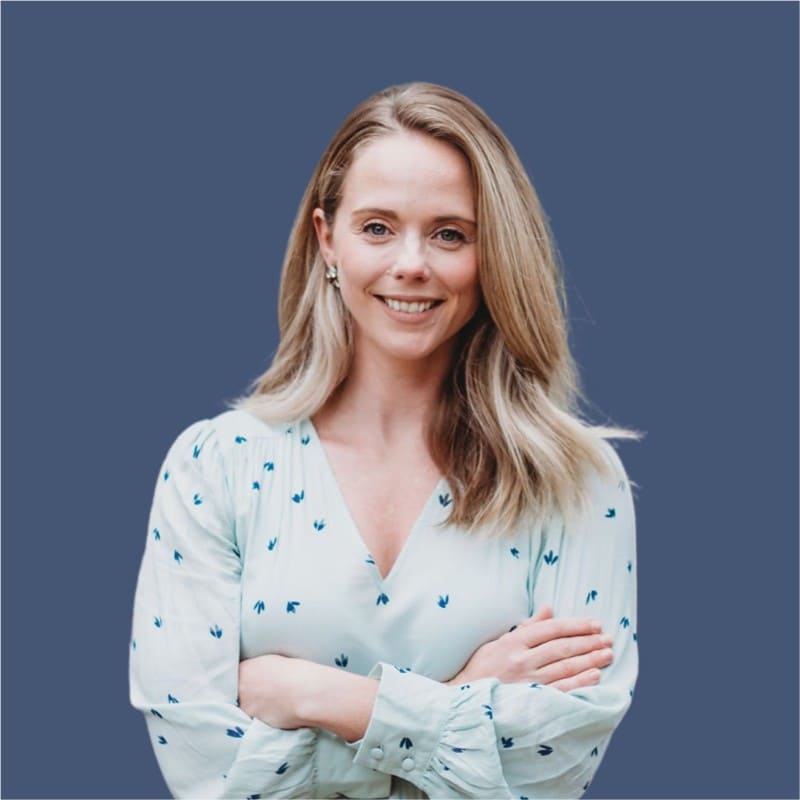
Founder, Child Life On Call

The team from Mindbowser stayed on task, asked the right questions, and completed the required tasks in a timely fashion! Strong work team!
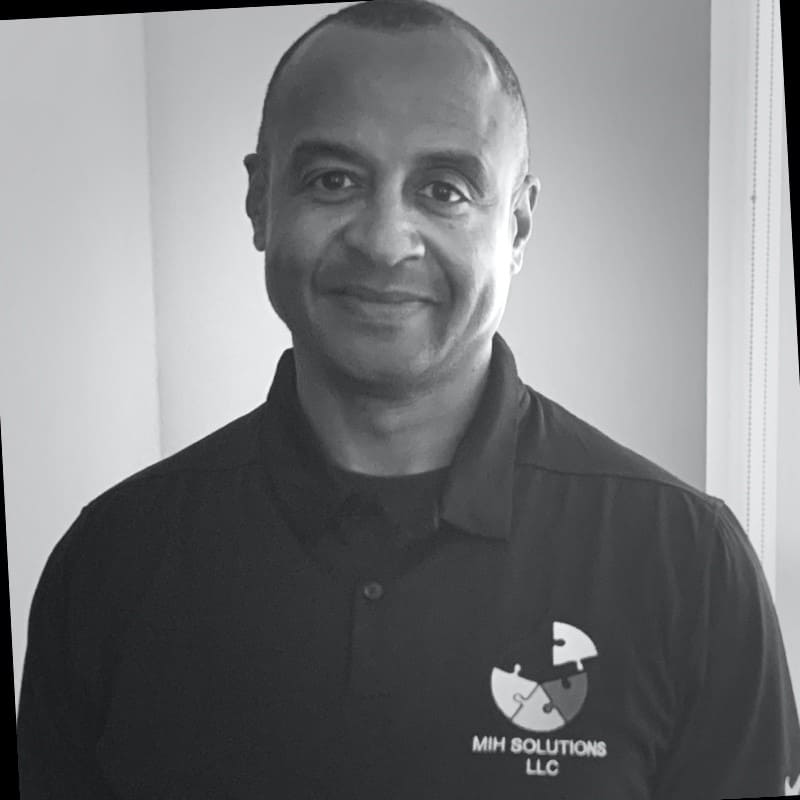
CEO, SDOH2Health LLC

Mindbowser was easy to work with and hit the ground running, immediately feeling like part of our team.

CEO, Stealth Startup

Mindbowser was an excellent partner in developing my fitness app. They were patient, attentive, & understood my business needs. The end product exceeded my expectations. Thrilled to share it globally.

Owner, Phalanx

Mindbowser's expertise in tech, process & mobile development made them our choice for our app. The team was dedicated to the process & delivered high-quality features on time. They also gave valuable industry advice. Highly recommend them for app development...

Co-Founder, Fox&Fork
